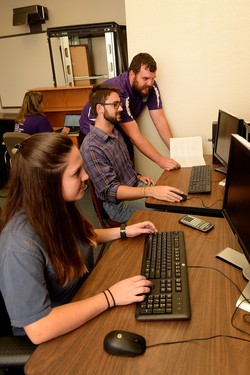SFA students leave their fingerprints on chemical research
October 11, 2017
 Dr. Brian Barngrover, Stephen F. Austin State University assistant professor of biochemistry and chemistry, oversees Russell Stager, senior chemistry student, and Alaina Spurr, senior biochemistry student, with their research on latent fingerprinting techniques. Stager and Spurr are attempting to determine the chemical reactions that occur during the fingerprinting process using computational chemistry, a method that relies on computers to determine energy reactions.
Dr. Brian Barngrover, Stephen F. Austin State University assistant professor of biochemistry and chemistry, oversees Russell Stager, senior chemistry student, and Alaina Spurr, senior biochemistry student, with their research on latent fingerprinting techniques. Stager and Spurr are attempting to determine the chemical reactions that occur during the fingerprinting process using computational chemistry, a method that relies on computers to determine energy reactions.
Alaina Spurr, a senior biochemistry major from The Colony, is focusing on 1,8-Diazaflouren-9-one, a chemical used to locate fingerprints on porous surfaces by making them glow when lit by a blue-green light, while Russell Stager, a senior chemistry major from McKinney, is studying 1,2-Indanedione, a chemical applied to porous items of evidence that reacts with amino acids in fingerprint residue and produces a fluorescent impression when the reaction is complete.
Both students are attempting to determine why each chemical reacts with Serine, the most abundant amino acid in perspiration.
In forensics, latent fingerprints are prints left on a porous surface at the scene of a crime that may not be immediately visible to the naked eye. To expose them, technicians use a variety of methods, including1,8-Diazaflouren-9-one, the most popular, while 1,2-Indanedione, is second in popularity. The latent prints comprise perspiration and oils.
"What I'm trying to figure out is how 1,8-Diazaflouren-9-one reacts to Serine," Spurr said. "We already know it works, but we don't know how they react to one another."
Research labs have used fingerprinting techniques, like the ones Spurr and Stager are studying, to secure forensic evidence for decades. Spurr explained that understanding how Serine reacts with the latent-fingerprinting chemicals is key to more efficient fingerprinting data and could help improve latent fingerprinting's accuracy and speed.
Spurr and Stager work in a dry lab, meaning they do not handle chemicals. Instead, they use computational chemistry, which uses computer simulations to help solve chemical problems, to complete their research.
To conduct their research, Spurr and Stager took their molecules of interest and input them into the computer. From there, the computer performs mathematical calculations on the molecules, and Spurr and Stager must then determine if the output makes chemical sense. The value and structure given may result in an energy that is too high or unrealistic, which would send them back to the drawing board. This process is repeated until logical results are determined.
Computational chemistry requires the equations to be inputted, and then the computer completes the math. Some equations can take up to five hours for the computer to solve, which gives Spurr and Stager time to work on other class assignments.
"This research is not only useful for the future of fingerprinting, but also could have benefits for other research fields," Spurr said. "The research could prove useful to any area of chemistry."
Spurr and Stager have looked to Dr. Brian Barngrover, SFA assistant professor of chemistry and biochemistry, for guidance throughout their research. Barngrover initiated the project, but has since stepped back to allow Spurr and Stager to continue the majority of the work.
"I've read articles about the two most popular latent-fingerprinting methods," Barngrover said. "Many of these articles don't address why it works and don't seem dedicated to finding out. I wanted to see if Alaina and Russell could do the research and come to a conclusion."
Every SFA biochemistry and chemistry student is required to complete research that will be presented as his or her senior capstone project and at a conference. Spurr and Stager will present their research during the American Chemistry Society's Southwestern regional meeting Oct. 29 in Lubbock.
Barngrover said it's important for students to use the knowledge they learn in the classroom and apply it to theories and techniques in the lab one-on-one with professors. "These interactions lead to students being more involved in the classroom," Barngrover said.
Spurr serves as the Driving Jacks president and plans to work toward a master's and doctoral degree in forensic science. Stager said he hopes to some day teach science in high school.
"Conducting this research will no doubt benefit both of these students as they graduate and enter their professions," Barngrover said. "There's no substitute for spending time in a laboratory setting and witnessing firsthand how to quantify your results. That's one area of many where SFA excels."